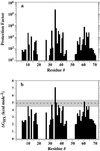Solution structure and dynamics of a de novo designed three-helix bundle protein
- PMID: 10318910
- PMCID: PMC21886
- DOI: 10.1073/pnas.96.10.5486
Solution structure and dynamics of a de novo designed three-helix bundle protein
Abstract
Although de novo protein design is an important endeavor with implications for understanding protein folding, until now, structures have been determined for only a few 25- to 30-residue designed miniproteins. Here, the NMR solution structure of a complex 73-residue three-helix bundle protein, alpha3D, is reported. The structure of alpha3D was not based on any natural protein, and yet it shows thermodynamic and spectroscopic properties typical of native proteins. A variety of features contribute to its unique structure, including electrostatics, the packing of a diverse set of hydrophobic side chains, and a loop that incorporates common capping motifs. Thus, it is now possible to design a complex protein with a well defined and predictable three-dimensional structure.
Figures




References
-
- Bryson J W, Betz S F, Lu H S, Suich D J, Zhou H X, O’Neil K T, DeGrado W F. Science. 1995;270:935–941. - PubMed
-
- Beasley J R, Hecht M H. J Biol Chem. 1997;272:2031–2034. - PubMed
-
- Hellinga H. Fold Des. 1998;3:1–8. - PubMed
-
- Regan L. Structure (London) 1998;6:1–4. - PubMed
-
- Choo Y, Castellanos A, Garcia-Hernandez B, Sanchez-Garcia I, Klug A. J Mol Biol. 1997;273:525–532. - PubMed
Publication types
MeSH terms
Substances
Associated data
- Actions
Grants and funding
LinkOut - more resources
Full Text Sources
Other Literature Sources
Research Materials

